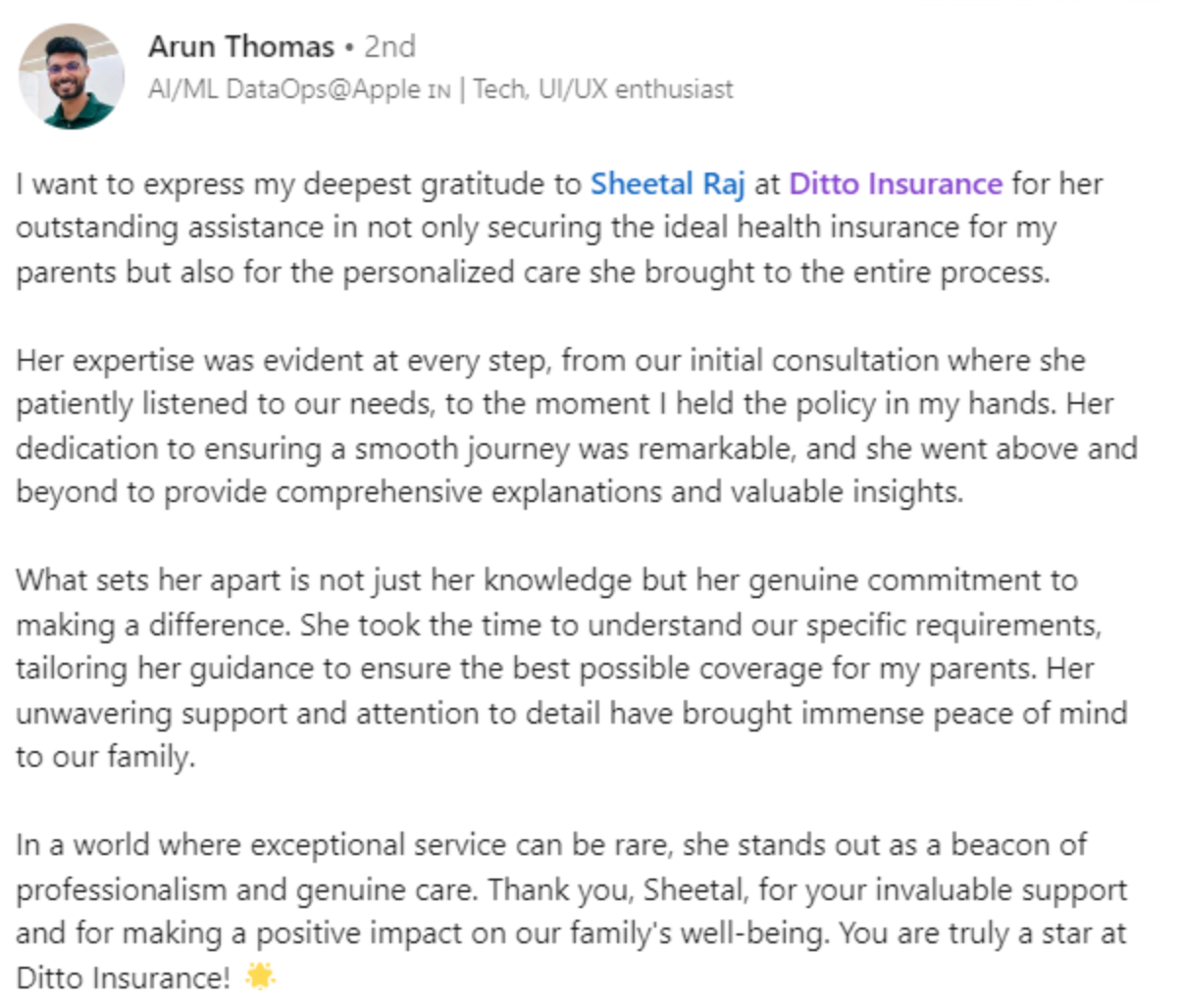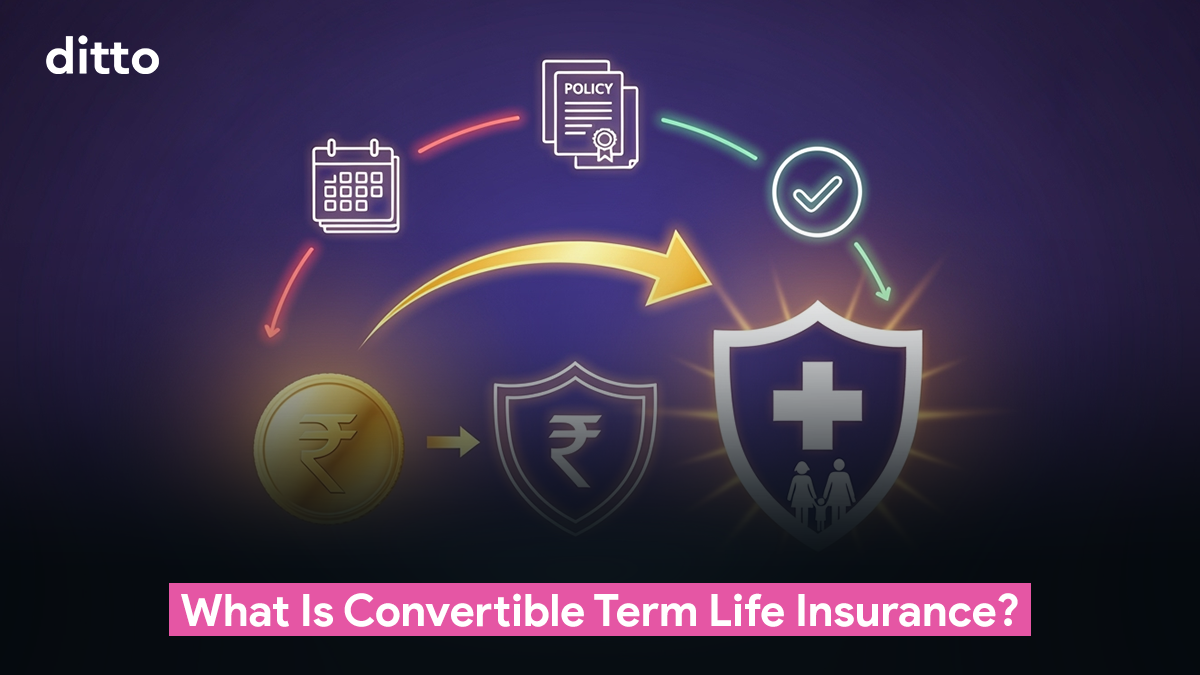| What is a Convertible Term Life Insurance? A Convertible Term Life Insurance policy starts as a standard term plan, providing coverage for a specific period. The unique feature of this plan is the option to convert it into a permanent life insurance policy, such as whole life or endowment, without undergoing a new medical examination. This flexibility allows policyholders to adapt their insurance coverage as their life circumstances change. This concept is quite popular abroad, especially in the US, though it is still relatively uncommon in India. |
Paying for life insurance in India often feels like choosing between two extremes. Term insurance is affordable but doesn’t cover you throughout your life, while whole life or endowment plans offer permanent cover at a much higher cost.
What if you could start with a low-cost option today and upgrade later without a fresh medical test? This is exactly what Convertible Term Life Insurance offers.
While these policies are widely available in the US, they’re currently not offered in India. Still, they’re worth understanding because they reveal how life insurance can evolve to serve changing financial needs.
At Ditto, our experts advise thousands of salaried and self-employed individuals every month, and that’s why we know flexibility is one of the biggest concerns people bring up.
Confused about what life insurance offering is right for you? Get free, no-spam advice from Ditto. Just 30 minutes to clear all your doubts. Book your call now.
What Is Convertible Term Life Insurance?
Convertible Term Life Insurance is a type of term policy that begins as affordable, temporary protection but gives you the option to convert it into permanent life insurance, like a whole life or endowment plan, without undergoing new medical exams or underwriting.
This makes it ideal for individuals who want low-cost coverage now, but also want the flexibility to upgrade later, especially if their health, financial responsibilities, or long-term goals change.Imagine a 28-year-old who buys a ₹1 crore term plan for 20 years. By the time they turn 40, their health has declined, and they now want extended coverage, keeping their legacy for their children in mind.
At this stage, applying for a new policy would mean fresh underwriting and a higher chance of rejection. With a convertible term plan, they can simply switch to permanent insurance with the same insurer without medicals and without the risk of rejection.
Globally (especially in the US), these plans are popular because but in India, convertible term plans are not yet available. Instead, most insurers offer either pure term plans or permanent policies, with no conversion feature in between.
| How Does Convertible Term Life Insurance Work? As discussed earlier, these plans are widely accessible in North America, but there are nuances to consider. a) Prudential (USA) - Term Essential: Conversion is allowed anytime during the level-premium period or up to the policy anniversary after age 65, whichever comes first. At least five years of convertibility are guaranteed, and partial conversions are possible. b) RBC (Canada) – YourTerm: You can convert all or part of your term policy to a permanent one without medical exams until the policy anniversary closest to age 71. What Happens at Conversion? You choose from eligible permanent plans, carrying over your existing health classification. This means premiums are recalculated based on your age and the new policy’s features, such as cash value or guarantees. Above all, convertible term plans are ideal for those seeking affordable coverage now with the flexibility to secure lifelong protection later. |
What are the Key Features of Convertible Term Life Insurance?
Convertible term life insurance comes with a unique mix of flexibility and protection. Here are the features that set it apart:
1. Affordable Entry Point: The policy begins as a standard term plan, which means you pay relatively low premiums for a substantial amount of coverage. Unlike permanent life insurance, which can be quite expensive from the start, a convertible term plan allows you to secure your family’s financial safety without straining your budget.
This makes it particularly useful for young professionals or families who want high coverage early in life but may not have the means to afford a costlier permanent plan.
2. Fixed Conversion Period: These policies come with a clearly defined conversion window, usually between 10 and 15 years, during which you can switch from term insurance to a permanent plan.
If you convert within this period, the insurer honors the agreement without additional conditions. However, if you miss the deadline, the policy remains a regular term plan until it expires. This fixed timeline encourages policyholders to evaluate their financial situation and long-term needs at the right stage of life.
3. Conversion Without Medicals: One of the standout benefits of a convertible term plan is the ability to convert without undergoing new medical tests or health assessments. Your eligibility is locked in at the time of purchase.
So, even if your health deteriorates over time due to age or illness, you can still upgrade to permanent coverage without fear of rejection. This feature provides peace of mind, especially for individuals with a family history of medical conditions.
4. Age-Based Premiums at Conversion: Although the conversion process is hassle-free from a medical standpoint, the cost of premiums will increase after you switch. That is because the insurer recalculates the premium based on your age at the time of conversion, not when you originally purchased the plan.
For example, if you bought the policy at 25 and decide to convert it at 40, your premiums will be pegged to the age of 40. This makes conversion convenient but also more expensive as you get older, especially since whole life policies, in general, tend to be significantly costlier.
5. Added Benefits Post-Conversion: Once converted, the policy shifts from being a pure risk cover to a permanent plan, such as a whole life or endowment policy. This means you don’t just retain the life cover but also start building a savings or investment component within the plan.In short, convertible term life insurance starts as an affordable risk-cover plan, gives you a fixed window to upgrade, allows conversion without health checks, adjusts premiums based on your age, and offers added financial benefits once converted.
| A Rare Indian Example: Kotak Term Plan Kotak’s Term Life Insurance plan offers a unique Conversion Option that lets you switch to any eligible Kotak Life policy (excluding term plans) without medical tests, provided at least five years remain on your term. a) At conversion, Kotak’s Term Life Insurance plan offers several key benefits: b) No health loadings or additional premiums are applied. You can select from any eligible Kotak Life policy available at the time, excluding term plans. c) The new plan will follow Kotak’s premium rates, sum assured limits, and eligibility rules in effect when you exercise the option. |
Advantages and Disadvantages of Convertible Term Life Insurance
Here’s the breakdown of the advantages and disadvantages of convertible term life insurance:
| Advantages | Disadvantages |
| Convertible term life insurance offers flexibility because it allows you to switch from temporary term coverage to permanent insurance when your needs change. | The premiums become much higher after conversion, since permanent insurance is significantly more expensive than term insurance. |
| There is no requirement for fresh medical tests during conversion, which means you can still qualify even if your health has worsened. | The option to convert is available only for a limited time, and if you miss this window, you lose the ability to convert in the future. |
| It provides peace of mind by ensuring that you can continue coverage without worrying about rejection due to health conditions later in life. | Convertible term life insurance is not available in India, as it is a feature offered mainly by insurers abroad. |
| Once converted into a permanent policy, the plan can build a cash value component, which can act as savings or be borrowed against. | Some people may end up paying for lifelong coverage that they do not actually need, which can lead to unnecessary expenses. |
Comparison of Pure Term Life vs Convertible Term Life Insurance
When choosing life insurance, it helps to understand the difference between pure term and convertible term policies. The table below provides a detailed, side-by-side comparison to help you evaluate which type of policy may suit your needs better.
| Pure Term Life Insurance | Convertible Term Life Insurance |
| Term life insurance provides coverage for a fixed period, such as 10, 20, or 30 years, and pays out only if the insured passes away during that term. | Convertible term life insurance also provides coverage for a fixed period but gives the option to switch to permanent insurance later without new medical tests. |
| It is usually the most affordable form of life insurance because it only offers pure protection without any savings component. | It starts as affordable, like normal term insurance, but can become much more expensive once converted to permanent coverage. |
| The policy has no cash value, which means it cannot be used as savings or invested; it only provides a death benefit. | After conversion, the permanent policy typically builds cash value, which can be accessed during the insured person’s lifetime. |
| Once the term expires, the policy ends unless renewed, often at a much higher cost, and renewal usually requires new health checks. | The ability to convert provides peace of mind, as you can continue coverage even if your health has declined, without the need to reapply or undergo medical exams. |
| It is widely available in India and is the most common form of life insurance purchased for financial protection. | Convertible term life insurance is not available in India and is currently offered mainly by insurance companies abroad. |
Points to Consider Before Buying a Convertible Term Plan
Before opting for a convertible term insurance plan, keep these key factors in mind:
- Conversion Timeframe: Check how long you have to exercise the conversion option.
- Eligible Plans: Understand which types of permanent plans you can switch to under your policy.
- Rider Options: Many term plans offer add-ons such as critical illness cover or accidental disability cover. It is important to check how these riders are treated at the time of conversion, as their terms and availability may change.
- Premium Changes: Conversion offers convenience, but premiums for permanent plans like whole life or endowment will be higher.
- Policy Term: Ensure the term length fits your long‑term financial goals.
- Insurer’s Rules: Conversion features and conditions vary between insurers, so it is important to read your policy documents carefully before deciding.
Why Talk to Ditto for Term Insurance?
At Ditto, we’ve assisted over 8,00,000 customers with choosing the right insurance policy. Why customers like Arun below love us:

✅No-Spam & No Salesmen
✅Rated 4.9/5 on Google Reviews by 15,000+ happy customers
✅Backed by Zerodha
✅Dedicated Claim Support Team
✅100% Free Consultation
You can book a FREE consultation here. Slots are running out, so make sure you book a call now.
Convertible Term Life Insurance: Is it a Good Idea? Ditto’s Take
From a global perspective, convertible term life insurance is a smart middle ground. It is especially beneficial for:
- Young buyers who want affordable coverage now but anticipate needing permanent coverage later.
- People with family health risks worry they may not qualify for insurance in the future.
- Professionals with rising incomes who may want to add a savings component later.
However, in the Indian context, these plans do not yet exist. Indian insurers typically prefer selling separate term and endowment/whole life products, and because demand for pure term insurance is relatively new, hybrid options like convertible term plans have not yet entered the market.
To tip the scales in its favour, the Indian insurance market enables you to lock in your premiums for the entire policy tenure under IRDAI regulations, with coverage available up to age 85 or even 99/100 in rare cases.
So, if your requirement is lifetime coverage and you want to leave a guarantee for your loved ones, increasing your term plan duration can be a simpler alternative to conversion, though premiums can be 40–150% higher depending on the length of coverage.
At Ditto, when customers ask about convertible term life insurance, we usually recommend buying a solid pure term plan for protection. If wealth-building becomes a priority later, it is advisable to invest separately in mutual funds or retirement plans.
Frequently Asked Questions (FAQs)
What are the alternatives to Convertible Term Life Insurance in India?
In India, you can opt for long-term plans lasting up to 40–50 years or until age 99/100 for extended coverage. Adding critical illness riders and combining term insurance with investments like mutual funds or the National Pension Scheme (NPS) can enhance protection and wealth-building.
How does a Convertible Term Policy differ from a Regular Term Policy?
A regular term policy provides coverage only for a fixed period and ends when that period expires. In contrast, a convertible term policy gives you the flexibility to switch to a permanent insurance plan without needing to reapply or undergo further medical examinations.
When is the right time to convert a Term Policy into Permanent Insurance?
The best time to convert is before the conversion window closes, so it is important to check your policy for the exact conversion period and other key terms and conditions. Conversion also makes sense when your financial goals evolve from simple protection to include wealth-building and legacy planning.
Last updated on:







